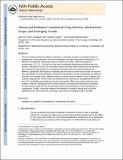Ultrasound-mediated transdermal drug delivery: Mechanisms, scope, and emerging trends
Author(s)
Polat, Baris E.; Hart, Douglas; Langer, Robert; Blankschtein, Daniel
DownloadHart_Ultrasound-mediated.pdf (2.642Mb)
PUBLISHER_CC
Publisher with Creative Commons License
Creative Commons Attribution
Terms of use
Metadata
Show full item recordAbstract
The use of ultrasound for the delivery of drugs to, or through, the skin is commonly known as sonophoresis or phonophoresis. The use of therapeutic and high frequencies of ultrasound (≥ 0.7 MHz) for sonophoresis (HFS) dates back to as early as the 1950s, while low-frequency sonophoresis (LFS, 20–100 kHz) has only been investigated significantly during the past two decades. Although HFS and LFS are similar because they both utilize ultrasound to increase the skin penetration of permeants, the mechanisms associated with each physical enhancer are different. Specifically, the location of cavitation and the extent to which each process can increase skin permeability are quite dissimilar. Although the applications of both technologies are different, they each have strengths that could allow them to improve current methods of local, regional, and systemic drug delivery. In this review, we will discuss the mechanisms associated with both HFS and LFS, specifically concentrating on the key mechanistic differences between these two skin treatment methods. Background on the relevant physics associated with ultrasound transmitted through aqueous media will also be discussed, along with implications of these phenomena on sonophoresis. Finally, a thorough review of the literature is included, dating back to the first published reports of sonophoresis, including a discussion of emerging trends in the field.
Date issued
2011-01Department
Massachusetts Institute of Technology. Department of Chemical Engineering; Massachusetts Institute of Technology. Department of Mechanical EngineeringJournal
Journal of Controlled Release
Publisher
Elsevier
Citation
Polat, Baris E., Douglas Hart, Robert Langer, and Daniel Blankschtein. “Ultrasound-Mediated Transdermal Drug Delivery: Mechanisms, Scope, and Emerging Trends.” Journal of Controlled Release 152, no. 3 (June 2011): 330–348.
Version: Author's final manuscript
ISSN
01683659